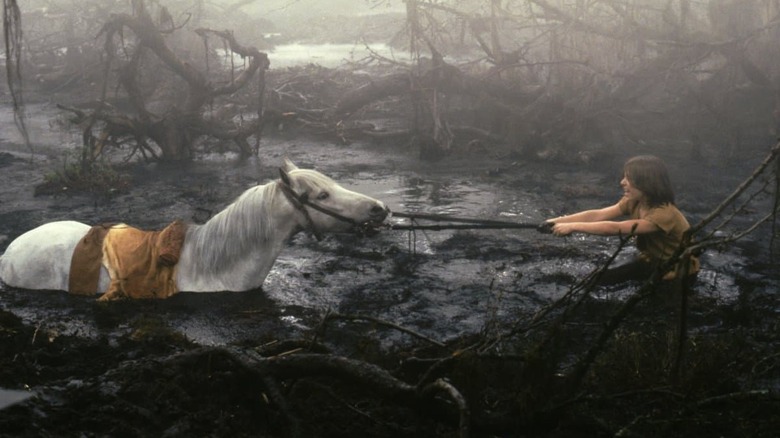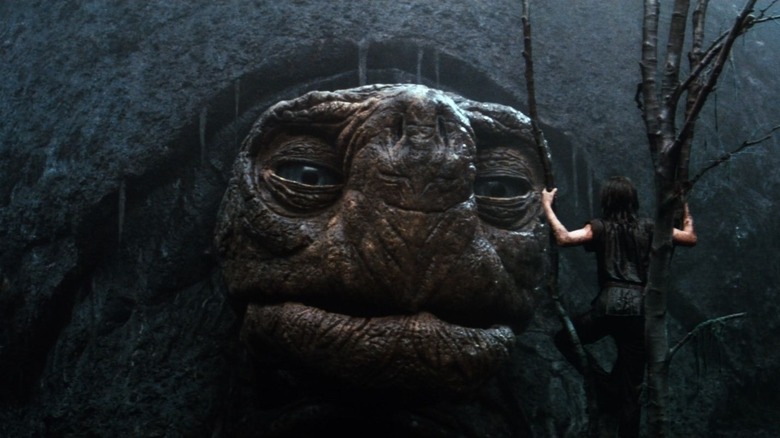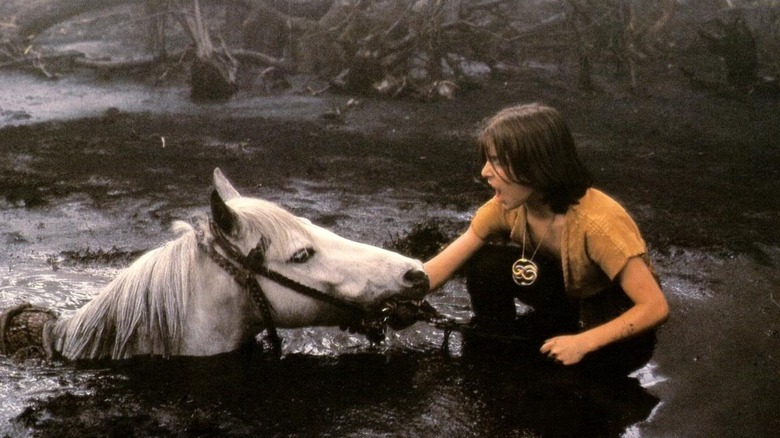Wolfgang Petersen Traumatized An Entire Generation Of Children With That Scene In The NeverEnding Story.
The late Wolfgang Petersen's 1984 film "The NeverEnding Story," while ostensibly a fantasy film, lacks the genre's expected sense of lighthearted, dazzling wonderment. Indeed, the film's fantasy sequences bear a tragic note of muddy entropy, and fantastical characters live in a state of resigned abnegation. Despite amazing special effects and myriad imaginative monsters, "The NeverEnding Story" is most notable for its overwhelming ennui. A savvy youth might be so beleaguered by the film's sadness, they may find its final moments of triumph to feel artificial, like the hero may only be imagining his own escape from pain. The film ends with a moment of mourning, of acceptance that a parent is dead. Some find the film uplifting. Others may not.
The plot of "The NeverEnding Story" follows a young boy named Bastian (Barret Oliver) who recently lost his mother and who is beset by bullies at school. When he absconds to his school attic with a stolen fantasy novel, he reads a tale of despair and sadness. In the book, the fantasy empire of Fantasia is being consumed by a force called The Nothing. To match his own sadness, the universe of Fantasia is giving over to hopelessness. The Empress (Tami Stronach), only a girl, is wasting away from sickness. Only a pre-teen hero named Atreyu (Noah Hathaway) can find a cure and stave of The Nothing. On his trail is an envoy of nihilism, a talking wolf called The Gmork (Allan Oppenheimer).
Atreyu's quest leads him and his beloved horse Artax into a dangerous swamp. Not pulling any punches, Petersen elected to feed the horse into the swamp, slowly killing it while Atreyu — and a generation of young children — looked on in horror and helplessness.
The Swamp of Sadness
The death of Artax has been considered a formative experience for many children. Witnessing the slow, painful death of an animal — all while its owner screams in agony — left its mark. "The NeverEnding Story" is set in a world of grief and lamentation, and communicated to children that death exists, and sadness will consume any of us. Even a horse.
Atreyu was on his way to speak to an impossibly ancient talking turtle named Morla (Robert Easton) who hasn't spoken to anyone in thousands of years. Morla lives in a hazy swamp called The Swamp of Sadness, a magical place that swallows up and kills anyone feeling despair. As one traverses through the mud, their sadness increases. If they become sad enough, they are sucked under the water and drown. Atreyu, determined on his quest, does not succumb, but Artax does. Artax, it seems, is carrying an unnamed hurt in his equine heart, and the Swamp of Sadness slowly envelops him. Atreyu can do nothing. Atreyu pulls on Artax's reins, screaming at the animal, pleading that it not give into sadness. The horse cannot, and it dies.
Atreyu watches in horror, and then sits on a rock and weeps deeply for his lost companion. There was nothing he could do. This scene is followed by a conversation with Morla that contains lines of dialogue like "We don't even care whether or not we care." Sadness is in all of us, death is inevitable, and our gods are indifferent. Indeed, they have an allergy to humans. "Die? At least that would be something." Is Bastian reading a fantasy novel or Albert Camus?
Depression
What does a horse have to be sad about? One cannot tell. Artax does not speak; He is just an animal. Artax does not have a story about how he once had hope, only to lose it through trauma. It wasn't until he begins to sink that the audience got any sense that the horse was depressed at all.
Watching Artax slowly sink into his own despondency may serve as a potent metaphor for depression, and how we may not be able to see it in those around us. Depression is not visible. Even the people we live with may be carrying weight without our noticing. The painful, real-life experience of seeing someone detach and sink downward — and to be helpless to interject — might feel like watching a trusty companion slowly sinking in the mud. Atreyu, a child himself, has no recourse but to scream and pull and beg Artax to not be depressed. Atreyu, and the audience, is unable to see or hear Artax's true inner pain. "The NeverEnding Story" taught young children that the people they live with may be unexpected repositories of anguish. After the Artax scenes, Atreyu's mounting of a furry, doglike luck dragon isn't much consolation.
At the conclusion of "The NeverEnding Story," Bastian finds that he can resurrect the withering Fantasia and rid the world of nihilism through the magical power of his own imagination. Bastian resurrects Artax and mounts a luck dragon of his own. Perceptive children may feel a temporary thrill in seeing Artax alive again, but will know deep in their hearts that Artax is still somehow deeply sad.
Many thanks to Wolfgang Petersen for allowing children their first taste of philosophical wretchedness.


